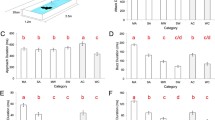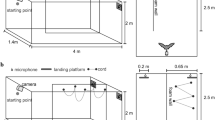Abstract
Echolocating insectivorous bats consummate prey captures using a distinct vocal motor pattern commonly known as the terminal or feeding buzz, which is widely considered a fixed motor pattern executed independently of auditory feedback influences. The Mexican free-tailed bat, Tadarida brasiliensis, offers an opportunity to explore the role of sensory feedback in buzzing because they emit similar buzzes both in flight during foraging and while stationary as communication sounds. Here we compared the spectral and temporal patterns of foraging and communication buzzes to address whether or not auditory feedback may influence buzz patterns. We found that while foraging buzzes uttered in open space were composed of generic FM calls, communication buzzes were composed of an adapted CF–FM call similar to the call type used by T. brasiliensis when navigating in confined spaces. This provides the first evidence that some bats can make significant context-dependent changes in the spectral parameters of calls within their buzz. We also found that inter-pulse intervals, but not call durations, were different within the two buzz types. These observations indicate that though a common pattern generator hierarchically organizes all buzzes, T. brasiliensis retains a significant capacity to adapt the spectral and temporal patterns of elements within its buzzes.








Similar content being viewed by others
References
Dusterhoft F, Hausler U, Jürgens U (2000) On the search for the vocal pattern generator. A single-unit recording study. Neuroreport 11:2031–2034
Fenzl T, Schuller G (2002) Periaqueductal gray and the region of the paralemniscal area have different functions in the control of vocalization in the neotropical bat, Phyllostomus discolor. Eur J Neurosci 16:1974–1986
Fenzl T, Schuller G (2005) Echolocation calls and communication calls are controlled differentially in the brainstem of the bat Phyllostomus discolor. BMC Biol 3:17
Gaioni SJ, Riquimaroux H, Suga N (1990) Biosonar behavior of mustached bats swung on a pendulum prior to cortical ablation. J Neurophysiol 64:1801–1817
Griffin DR (1958) Listening in the dark; the acoustic orientation of bats and men. Yale University Press, New Haven
Hage SR, Jürgens U (2006) Localization of a vocal pattern generator in the pontine brainstem of the squirrel monkey. Eur J Neurosci 23:840–844
Holderied MW, Helversen Ov (2003) Echolocation range and wingbeat period match in aerial-hawking bats. Proc R Soc Lond B 270:2293–2299
Jürgens U (2000) Localization of a pontine vocalization-controlling area. J Acoust Soc Am 108:1393–1396
Kalko EKV (1989) The echolocation and hunting behavior of Daubenton’s bat, Myotis daubentoni. Behav Ecol Sociobiol 24:225–238
Kalko EKV (1995) Insect pursuit, prey capture and echolocation in pipistrelle bats (Microchiroptera). Anim Behav 50:861–880
Ma T, French B, Page R, Pollak G (2004) The social communication calls and songs of Mexican free-tailed bats. In: Assoc Res Otolaryngol. Abs, p 1093
Metzner W (1989) A possible neuronal basis for Doppler-shift compensation in echo-locating horseshoe bats. Nature 341:529–532
Moss CF, Sinha SR (2003) Neurobiology of echolocation in bats. Curr Opin Neurobiol 13:751–758
Moss CF, Bohn K, Gilkenson H, Surlykke A (2006) Active listening for spatial orientation in a complex auditory scene. PLoS Biol 4:e79
Obrist MK (1995) Flexible bat echolocation-the influence of individual, habitat and conspecifics on sonar signal design. Behav Ecol Sociobiol 36:207–219
Schmidly DJ, Wilkins KT, Honeycutt RL, Weynard BC (1977) The bats of east texas. Tex J Sci 28:127–143
Schnitzler H-U, Kalko EKV (2001) Echolocation by insect-eating bats. Bioscience 51:557–569
Schnitzler HU, Kalko E, Miller L, Surlykke A (1987) The echolocation and hunting behavior of the bat, Pipistrellus kuhli. J Comp Physiol A 161:267–274
Schnitzler HU, Kalko EKV, Kaipf I, Grinnell AD (1994) Fishing and echolocation behavior of the greater bulldog bat, Noctilio leporinus, in the field. Behav Ecol Sociobiol 35:327–345
Schuller G (1986) Influence of echolocation pulse rate on Doppler-shift compensation control system in the Greater Horseshoe Bat. J Comp Physiol A 158:239–246
Schuller G, Radtke-Schuller S (1986) Neural control of vocalization in bats at peripheral and midbrain levels. In: Newman JD (ed) The physiological control of mammalian vocalization. Plenum Press, New York, pp 67–86
Schuller G, Radtke-Schuller S (1990) Neural control of vocalization in bats: mapping of brainstem areas with electrical microstimulation eliciting species-specific echolocation calls in the rufous horseshoe bat. Exp Brain Res 79:192–206
Siemers BM, Schnitzler HU (2004) Echolocation signals reflect niche differentiation in five sympatric congeneric bat species. Nature 429:657–661
Simmons JA, Lavender WA, Lavender BA, Childs JE, Hulebak K, Rigden MR, Sherman J, Woolman B (1978) Echolocation by free-tailed bats (Tadarida). J Comp Physiol A 125:291–299
Smotherman M, Metzner W (2005) Auditory-feedback control of temporal call patterns in echolocating horseshoe bats. J Neurophysiol 93:1295–1303
Smotherman M, Zhang S, Metzner W (2003) A neural basis for auditory feedback control of vocal pitch. J Neurosci 23:1464–1477
Smotherman M, Kobayasi K, Ma J, Zhang S, Metzner W (2006) A mechanism for vocal-respiratory coupling in the mammalian parabrachial nucleus. J Neurosci 26:4860–4869
Suga N, Yajima Y (1986) Auditory-vocal integration in the midbrain of the mustached bat. In: Newman JD (ed) The physiological control of mammalian vocalization. Plenum Press, New York, pp 87–108
Suga N, Schlegel P, Shimozawa T, Simmons J (1973) Orientation sounds evoked from echolocating bats by electrical stimulation of the brain. J Acoust Soc Am 54:793–797
Surlykke A, Moss CF (2000) Echolocation behavior of big brown bats, Eptesicus fuscus, in the field and the laboratory. J Acoust Soc Am 108:2419–2429
Surlykke A, Miller LA, Møhl B, Andersen BB, Christensen-Dalsgaard J (1993) Echolocation in two very small bats from Thailand: Craseonycteris thonglongyai and Myotis siligorensis. Behav Ecol Sociobiol 33:1–12
Acknowledgments
We thank Mr. Clint Netherland and the Texas A&M University Athletic Department for access to the bats of Kyle Field. We thank the Texas Parks and Wildlife Department for the collection permits. We thank Ms. Barbara French (Bat Conservation International, Austin TX) and Dr. George Pollak (University of Texas at Austin) for introducing us to the vocal behavior of the Mexican free-tailed bat and for many informative discussions. We also thank Bob and Joyce Rogers for permission to record bats foraging over their pond.
Author information
Authors and Affiliations
Corresponding author
Rights and permissions
About this article
Cite this article
Schwartz, C., Tressler, J., Keller, H. et al. The tiny difference between foraging and communication buzzes uttered by the Mexican free-tailed bat, Tadarida brasiliensis . J Comp Physiol A 193, 853–863 (2007). https://doi.org/10.1007/s00359-007-0237-7
Received:
Revised:
Accepted:
Published:
Issue Date:
DOI: https://doi.org/10.1007/s00359-007-0237-7




